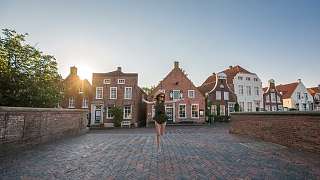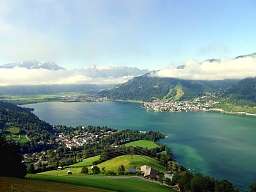Romantik Blog
Pretty North Sea towns and harbour villages
After a long day at the beach, on the mudflats or on a surfboard, stroll through the picturesque city centre and, after a cup of East Frisian tea, explore the museums and exhibitions in the area? A city holiday on the North Sea coast is the perfect destination for anyone who doesn't want to choose between an active holiday, a relaxing beach holiday or a cultural city break. But holidaymakers are spoilt for choice; set in idyllic natural surroundings, one town is more beautiful than the next. Some are enchantingly small and sleepy, others vibrant and full of life, making it difficult to choose a city break. The text provides a brief overview of selected North Sea gems, all of which have their own unique charm and character. If you don't want to decide, combine city hopping with a bicycle tour. Or visit the coast again every year. With such a wide range of cultural and leisure activities on offer, you certainly won't get bored on a North Sea city break in these wonderful North Sea towns.
Greetsiel
Historic gabled houses with colourful facades, charming alleyways, a 600-year-old, quaint fishing harbour with an impressive shrimp cutter fleet - the Nordic town of Greetsiel is an absolute holiday highlight. Anyone who visits the former fishing village is enveloped in the magic of the past. Here you will find the typical East Frisia of old: Gulf farms, the historic twin windmills that greet you at the entrance to the village, chieftain's castles and probably the smallest lighthouse in Germany. Once you have strolled through the picturesque centre of Greetsiel, you can enjoy freshly caught garnet, as the crabs are called here, at the harbour or eat plaice, plaice, sole or other culinary North Sea treasures in one of the fish restaurants. In stormy North Sea weather, there is certainly no cosier place for a dark East Frisian tea and cream cake than in the old granary in one of the twin windmills at the entrance to the village (Schoofs Mühlencafé). When the sun is shining, you can also sit on the terrace directly on the water. In August, the tranquil little town is transformed into a place of revelry. That's when the "Wält Championship" in mud sledge racing takes place, also known as Carnival on the Mudflats. An event that attracts more than ten thousand visitors every year. The prize is awarded to the fastest team with the best costume.
Norden
Norden - and we don't mean the point of the compass, but the oldest town in East Frisia - is the perfect destination for a varied active holiday surrounded by historical sights. The most north-westerly town on the German mainland has a beautiful old town with a picturesque market square, surrounded by a stand of old trees - many of which are over 250 years old. Here you will find the Ludgerikirche, the largest church in East Frisia. Its construction began in 1235, the freestanding bell tower on the other side of the street dates from the 14th century. In addition to many art-historical treasures, the Ludgeri Church houses the second largest preserved Arp Schnitger organ in Germany. On the south side of the market square is the building ensemble of the "Dree Süsters" (three sisters). It consists of three beautiful Renaissance brick buildings and was built around 1600. And to stay with the magic number: There are also three historic mills in the town area: the Deichmühle, the Frisia-Mühle and the Westgaster Mühle. Holidaymakers can visit the local history museum in the old town hall. The tea museum is also located there and makes you want to spend a cosy afternoon with a smoky East Frisian blend in your cup and a big piece of cake on your plate. Cosy cafés can be found all over the city. The Nörder, as the inhabitants of Norden are affectionately called in Low German, brave the rough sea with a pronounced sense of cosiness.
Speaking of rough seas: Norden's Norddeich is the largest state-recognised seaside spa on the North Sea coast. As early as the 1950s, Norden became known as "the green gateway to the sea", because the pretty coastal town not only encourages you to take a leisurely stroll through the town, but also to go for long walks in the surrounding natural idyll - including extensive hikes through the magnificent mudflats. Here, the wind drives away the last of your everyday worries. Animal lovers should definitely make a trip to the seal station Nationalpark-Haus in Norddeich. Visitors can watch sick or motherless mammals being cared for. An exhibition provides information on seals, grey seals and other marine mammals. The whale museum in the Osterloog district is fascinating. Here you can see, among other things, the skeleton of a 15-metre-long, two-tonne sperm whale that was found in the Norddeich mudflats.
Juist: East Frisian island and harbour town
At 17 kilometres, Juist is the longest of the seven East Frisian North Sea islands, but its 500-metre width also makes it the smallest. The islanders affectionately call it Töwerland, which means magic land. Anyone who visits it knows why. The reddish sparkling sunset over the white sandbanks, the light of the Memmertfeuer lighthouse at night, the magnificent salt marshes, and in the midst of this extraordinary beauty, nostalgic carriages leisurely driving along the island paths. With a few exceptions, cars have been banned on Juist for decades. There are two small villages in Töwerland: Juist, which bears the island's name, and Loog, which means village in Frisian. In the ferry harbour, holidaymakers will find restaurants, shopping facilities and a spa centre with a Thalasso centre. The spa park is a meeting place with tradition. Young and old have been meeting here for generations to launch their self-made miniature ships into the spa lake. In the National Park House in the old railway station, you can learn a lot of interesting facts about the Lower Saxony Wadden Sea National Park, which is a UNESCO World Heritage Site. Those who want to learn about the island's eventful history and are interested in all topics related to shipping will find comprehensive information at the Coastal Museum in Loog, which is well worth seeing. Good news for lovers: if you want, you can get married in the historic brick building of the "Alter Warmbad". It would be hard to find a more romantic place to start your marriage.
Cuxhaven
Cuxhaven is located at the northernmost tip of Lower Saxony and was one of the most exclusive seaside resorts in the North Sea in the 19th century. Whereas in those days only aristocrats and the wealthiest bourgeoisie travelled here, today Cuxhaven is open to all those seeking recreation. Surrounded by Caribbean beaches, the idyllic coastal heath and the Wernerwald nature reserve, the town has become a mecca for active holidaymakers and culture lovers. The Kugelbake is the city's landmark. The 29-metre-high sea marker marks the border between the Elbe and the sea, and was an important navigational aid in its day. Cuxhaven has a large number of museums. Those interested in great word art and painting should not miss the Joachim Ringelnatz Museum. The Hapag Halls are also a special cultural experience. Here the stories of emigrants who left Cuxhaven for America are shown.
Husum
In 1851, Theodor Storm called his hometown a "grey town by the sea". Today, Husum looks more like a picture-book town, with its splendid houses decorated with colourful façades, romantic lanes, the old harbour and the lively town centre. On the market square with the old town hall, the pretty St. Mary's Church and the historic Tine Fountain, the largest weekly market in North Friesland takes place every Thursday. Here you can buy regional and fresh delicacies and nibbles. Not far from the market square is Husum Castle, a picturesque 16th-century brick building that is now a cultural centre. The programme includes international piano festivals, various concerts and puppet shows for the whole family. The castle includes the museum with roof gallery, the Poppenspäler Museum, a castle café, the castle park and the magnificent Duchess Garden. In spring, the meadows surrounding Husum Castle are bathed in a delicate purple. More than 4 million crocuses then provide a unique splendour of blossoms, which the people of Humsum celebrate with the Crocus Blossom Festival. So much for a grey town by the sea! If you want to visit the former home of Theodor Storm, you will find it near the harbour, in Wasserreihe 31, where you can also admire the desk on which the world-famous writer wrote The Rider of the White Horse in the partly original rooms.
Post your comment
Comments
No one has commented on this page yet.
RSS feed for comments on this page RSS feed for all comments



